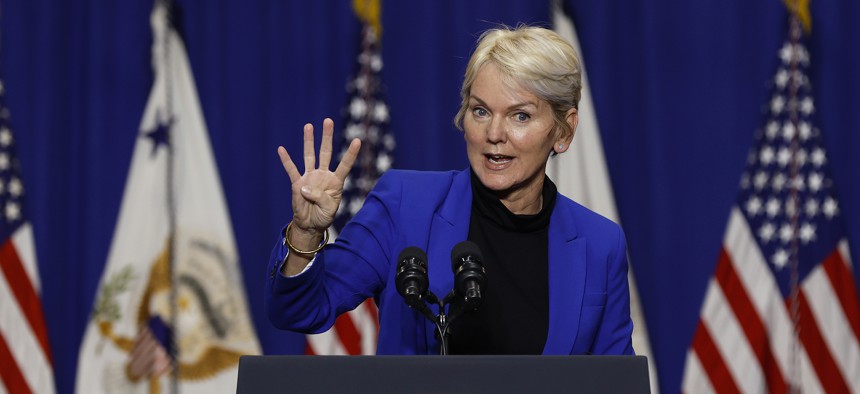Energy Launches New Program To Overhaul the U.S. Electrical Grid

DECEMBER 13: U.S. Energy Secretary Jennifer Granholm delivers remarks during an event at the Prince George’s County Brandywine Maintenance Facility on December 13, 2021 in Brandywine, Maryland. (Photo by Chip Somodevilla/Getty Images)
Pursuant to President Biden’s sustainable energy plans, the Department of Energy launched a new initiative to restore the country’s electrical grid through expanded access and more resilient systems.
The Department of Energy announced the launch of a new initiative Wednesday that focuses on upgrading the U.S.’ electrical grid in support of a more sustainable energy economy.
The program, dubbed the Building a Better Grid Initiative, takes cues from President Joe Biden’s plans to overhaul the country’s infrastructure in support of a nationwide transition to clean electricity by 2035.
“The foundation of our climate and clean energy goals is a safe, reliable, and resilient electric grid that is planned hand-in-hand with community partners and industry stakeholders,” said Energy Secretary Jennifer Granholm. “DOE’s new Building a Better Grid initiative is a job booster spurred by the Bipartisan Infrastructure Law and collaboration with communities to upgrade the nation’s grid, connect more Americans to clean electricity and broadband, and reliably move clean energy to where it’s needed most.”
A key component of the Building a Better Grid program is to ensure that the country’s electric grid is more resilient to weather patterns stemming from climate change. Energy officials cite recent meteorological events, such as the 2021 Texas Freeze and Dixie Wildfire, as examples of a weak electrical grid against worsening weather phenomenon.
With estimates citing roughly 70 percent of the U.S.’s electrical grid systems as over 25 years old, Energy officials also raised concerns about the current power system’s resilience against cyber threats.
To mitigate both of these outstanding threats, Energy will be investing over $20 billion in federal funding to expand the nation’s electrical grid and modernize its transmission capabilities through public and private partnerships as well as enhanced long-term research and development.
Engaging local, state and tribal governments will be a hallmark feature of the new initiative as the federal government works to expand new sustainable grid pathways.
“Transmission infrastructure is the backbone of a reliable, resilient, and clean electricity system. Significant transmission investments are needed to achieve our ambitious clean energy goals; however, today these investments face numerous barriers,” said Rep. Paul Tonko, D-N.Y.Tonko serves as chairman of the House Energy and Commerce Subcommittee for Environment and Climate Change.
Detailed in the corresponding notice of intent are the potential cost benefits of moving to a modernized and sustainable electrical grid. Officials state that clean energy solutions are becoming the cheapest alternative across the country, yet inaccessible for many parts of the country.
“The most cost-effective renewable resources are often located in remote geographic areas far from the areas with the biggest demand,” the notice reads. “Therefore, accelerating the shift toward a clean power sector requires investment in critical enabling infrastructure such as transmission to increase access to these renewable energy sources.”
This will involve deploying new interstate high-voltage power lines connecting areas with large volumes of renewable energy sources to locations with a high demand for electricity.
Offshore wind power is a sector that Energy is looking to invest heavily in as a cleaner energy solution, with the Biden Administration continuing to aim at a target of 30 gigawatts of power generated by offshore wind by 2030.
Belying all of these plans is the department’s understanding of the need to maintain grid reliability. Updating the current technology composing the electrical grid has the primary goal of ensuring long-term transmission benefits past a typical 10 year planning cycle, such as decarbonization and quicker outage recovery.
Much of these ambitions will hinge on the implementation of new technologies. $3 billion in funding from Biden’s landmark Infrastructure Investment and Jobs Act will be used by Energy to deploy advanced equipment like flow control devices, conductors, dynamic line rating, and other optimization technologies into building the new grid.
Throughout this process, Energy will be researching the cost of new technology to help regulate a more efficient electrical grid. The department’s 2022 budget prioritizes contract offers related to high voltage direct converter stations, storage capabilities, and transformers.
“DOE continues to conduct RD&D to further develop and reduce the costs of technologies that enable the transmission system to be used more efficiently, including grid enhancing technologies, improved transmission conductors, and grid-related energy storage facilities,” the notice stated.
